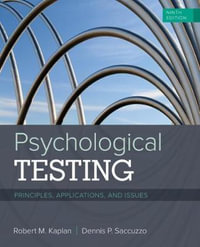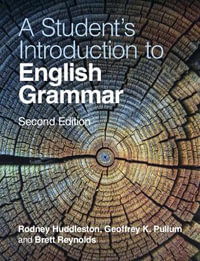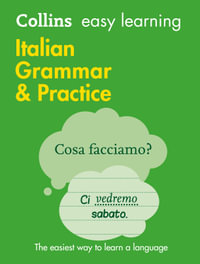
Corpus-Based Language Studies
An Advanced Resource Book
By: Anthony McEnery, Richard Xiao, Yukio Tono
Hardcover | 21 December 2005 | Edition Number 1
At a Glance
408 Pages
25.4 x 17.78 x 2.39
Hardcover
RRP $305.00
$283.25
or 4 interest-free payments of $70.81 with
orAims to ship in 7 to 10 business days
Routledge Applied Linguistics is a series of comprehensive textbooks, providing students and researchers with the support they need for advanced study in the core areas of English language and Applied Linguistics.
Each book in the series guides readers through three main sections, enabling them to explore and develop major themes within the discipline.
- Section A, Introduction, establishes the key terms and concepts and extends readersâ techniques of analysis through practical application.
- Section B, Extension, brings together influential articles, sets them in context, and discusses their contribution to the field.
- Section C, Exploration, builds on knowledge gained in the first two sections, setting thoughtful tasks around further illustrative material. This enables readers to engage more actively with the subject matter and encourages them to develop their own research responses.
Throughout the book, topics are revisited, extended, interwoven and deconstructed, with the readerâs understanding strengthened by tasks and follow-up questions.
Corpus-Based Language Studies:
- covers the major theoretical approaches to the use of corpus data
- adopts a âhow toâ approach with exercises and cases, affording students with the knowledge and tools to undertake their own corpus-based research
- gathers together influential readings from leading names in the discipline, including: Douglas Biber, Henry Widdowson, Michael Stubbs, Ronald Carter, and Michael McCarthy
- is supported by a website featuring long extracts for analysis by students with commentary by the authors.
The accompanying website to this book can be found at http://cw.routledge.com/textbooks/0415286239/
Industry Reviews
"This book is by far the most comprehensive introduction to corpus linguistics published to date. It is essentially three books in one: 1) a conceptual overview of analytical issues, techniques, and findings; 2) a collection of key articles published to date 3) and a set of case studies that fully illustrate the most important analytical and design issues. I will certainly be using the book as a required text in my own courses." Douglas Biber, Northern Arizona University
| Series editors' preface | p. xv |
| Preface | p. xvii |
| Acknowledgements | p. xix |
| Introduction | p. 1 |
| Corpus linguistics: the basics | p. 3 |
| Introduction | p. 3 |
| Corpus linguistics: past and present | p. 3 |
| What is a corpus? | p. 4 |
| Why use computers to study language? | p. 5 |
| The corpus-based approach vs. the intuition-based approach | p. 6 |
| Corpus linguistics: a methodology or a theory? | p. 7 |
| Corpus-based vs. corpus-driven approaches | p. 8 |
| Summary | p. 11 |
| Looking ahead | p. 12 |
| Representativeness, balance and sampling | p. 13 |
| Introduction | p. 13 |
| What does representativeness mean in corpus linguistics? | p. 13 |
| The representativeness of general and specialized corpora | p. 15 |
| Balance | p. 16 |
| Sampling | p. 19 |
| Summary | p. 21 |
| Looking ahead | p. 21 |
| Corpus mark-up | p. 22 |
| Introduction | p. 22 |
| The rationale for corpus mark-up | p. 22 |
| Corpus mark-up schemes | p. 23 |
| Character encoding | p. 27 |
| Summary | p. 28 |
| Looking ahead | p. 28 |
| Corpus annotation | p. 29 |
| Introduction | p. 29 |
| Corpus annotation = added value | p. 30 |
| How is corpus annotation achieved? | p. 33 |
| Types of corpus annotation | p. 33 |
| Embedded vs. standalone annotation | p. 44 |
| Summary | p. 44 |
| Looking ahead | p. 45 |
| Multilingual corpora | p. 46 |
| Introduction | p. 46 |
| Multilingual corpora: terminological issues | p. 47 |
| Corpus alignment | p. 50 |
| Summary | p. 51 |
| Looking ahead | p. 51 |
| Making statistical claims | p. 52 |
| Introduction | p. 52 |
| Raw frequency and normalized frequency | p. 52 |
| Descriptive and inferential statistics | p. 53 |
| Tests of statistical significance | p. 53 |
| Tests for significant collocations | p. 56 |
| Summary | p. 57 |
| Looking ahead | p. 57 |
| Using available corpora | p. 59 |
| Introduction | p. 59 |
| General corpora | p. 59 |
| Specialized corpora | p. 60 |
| Written corpora | p. 61 |
| Spoken corpora | p. 62 |
| Synchronic corpora | p. 64 |
| Diachronic corpora | p. 65 |
| Learner corpora | p. 65 |
| Monitor corpora | p. 67 |
| Summary | p. 69 |
| Looking ahead | p. 70 |
| Going solo: DIY corpora | p. 71 |
| Introduction | p. 71 |
| Corpus size | p. 71 |
| Balance and representativeness | p. 73 |
| Data capture | p. 73 |
| Corpus mark-up | p. 74 |
| Corpus annotation | p. 75 |
| Character encoding | p. 76 |
| Summary | p. 76 |
| Looking ahead | p. 76 |
| Copyright | p. 77 |
| Introduction | p. 77 |
| Coping with copyright: warning and advice | p. 77 |
| Summary | p. 78 |
| Looking ahead | p. 79 |
| Corpora and applied linguistics | p. 80 |
| Introduction | p. 80 |
| Lexicographic and lexical studies | p. 80 |
| Grammatical studies | p. 85 |
| Register variation and genre analysis | p. 87 |
| Dialect distinction and language variety | p. 90 |
| Contrastive and translation studies | p. 91 |
| Diachronic study and language change | p. 96 |
| Language learning and teaching | p. 97 |
| Semantics | p. 103 |
| Pragmatics | p. 104 |
| Sociolinguistis | p. 108 |
| Discourse analysis | p. 111 |
| Stylistics and literary studies | p. 113 |
| Forensic linguistics | p. 116 |
| What corpora cannot tell us | p. 120 |
| Summary | p. 121 |
| Looking ahead | p. 122 |
| Extension | p. 123 |
| Corpus representativeness and balance | p. 125 |
| Introduction | p. 125 |
| Biber (1993) | p. 125 |
| Atkins, Clear and Ostler (1992) | p. 128 |
| Summary | p. 130 |
| Looking ahead | p. 130 |
| Objections to corpora: an ongoing debate | p. 131 |
| Introduction | p. 131 |
| Widdowson (2000) | p. 131 |
| Stubbs (2001b) | p. 135 |
| Widdowson (1991) vs. Sinclair (1991b): a summary | p. 140 |
| Summary | p. 144 |
| Lexical and grammatical studies | p. 145 |
| Introduction | p. 145 |
| Krishnamurthy (2000) | p. 145 |
| Partington (2004) | p. 148 |
| Carter and McCarthy (1999) | p. 152 |
| Kreyer (2003) | p. 155 |
| Summary | p. 159 |
| Looking ahead | p. 159 |
| Language variation studies | p. 160 |
| Introduction | p. 160 |
| Biber (1995a) | p. 160 |
| Hyland (1999) | p. 165 |
| Lehmann (2002) | p. 169 |
| Kachru (2003) | p. 174 |
| Summary | p. 177 |
| Looking ahead | p. 177 |
| Contrastive and diachronic studies | p. 178 |
| Introduction | p. 178 |
| Altenberg and Granger (2002) | p. 178 |
| McEnery, Xiao and Mo (2003) | p. 181 |
| Kilpio (1997) | p. 185 |
| Mair, Hundt, Leech and Smith (2002) | p. 190 |
| Summary | p. 194 |
| Looking ahead | p. 194 |
| Language teaching and learning | p. 195 |
| Introduction | p. 195 |
| Gavioli and Aston (2001) | p. 195 |
| Thurston and Candlin (1998) | p. 198 |
| Conrad (1999) | p. 201 |
| Summary | p. 202 |
| Looking ahead | p. 203 |
| Exploration | p. 205 |
| Collocation and pedagogical lexicography Case study 1 | p. 208 |
| Introduction | p. 208 |
| Collocation information | p. 210 |
| Using corpus data for improving a dictionary entry | p. 220 |
| Summary | p. 225 |
| Further study | p. 225 |
| Help or Help to: what do corpora have to say? Case study 2 | p. 227 |
| Introduction | p. 227 |
| Concordancing | p. 228 |
| Language variety | p. 235 |
| Language change | p. 239 |
| An intervening NP | p. 240 |
| The infinite marker preceding Help | p. 241 |
| The passive construction | p. 245 |
| Summary | p. 246 |
| Further study | p. 246 |
| L2 acquisition of grammatical morphemes Case study 3 | p. 247 |
| Introduction | p. 247 |
| Morpheme studies: a short review | p. 249 |
| The Longman Learners' Corpus | p. 250 |
| Problem-oriented corpus annotation | p. 251 |
| Discussion | p. 260 |
| Summary | p. 263 |
| Further study | p. 263 |
| Swearing in modern British English Case study 4 | p. 264 |
| Introduction | p. 264 |
| Spoken vs. written register | p. 265 |
| Variations within spoken English | p. 269 |
| Variations within written English | p. 279 |
| Summary | p. 285 |
| Further study | p. 286 |
| Conversation and speech in American English Case study 5 | p. 287 |
| Introduction | p. 287 |
| Salient linguistic features | p. 288 |
| Basic statistical data from the corpus | p. 293 |
| The dimension scores of three genres | p. 303 |
| The keyword approach to genre analysis | p. 393 |
| Summary | p. 319 |
| Further study | p. 320 |
| Domains, text types, aspect marking and English-Chinese translation Case study 6 | p. 321 |
| Introduction | p. 321 |
| The corpus data | p. 223 |
| Translation of aspect marking | p. 324 |
| Translation and aspect marking | p. 336 |
| Domain and aspect marking | p. 338 |
| Text type and aspect marking | p. 340 |
| Summary | p. 341 |
| Further study | p. 343 |
| Glossary | p. 344 |
| Bibliography | p. 352 |
| Appendix of useful Internet links | p. 379 |
| Index | p. 381 |
| Table of Contents provided by Ingram. All Rights Reserved. |
ISBN: 9780415286220
ISBN-10: 0415286220
Series: Routledge Applied Linguistics
Published: 21st December 2005
Format: Hardcover
Language: English
Number of Pages: 408
Audience: Professional and Scholarly
Publisher: Taylor & Francis Ltd
Country of Publication: GB
Edition Number: 1
Dimensions (cm): 25.4 x 17.78 x 2.39
Weight (kg): 0.85
Shipping
| Standard Shipping | Express Shipping | |
|---|---|---|
| Metro postcodes: | $9.99 | $14.95 |
| Regional postcodes: | $9.99 | $14.95 |
| Rural postcodes: | $9.99 | $14.95 |
How to return your order
At Booktopia, we offer hassle-free returns in accordance with our returns policy. If you wish to return an item, please get in touch with Booktopia Customer Care.
Additional postage charges may be applicable.
Defective items
If there is a problem with any of the items received for your order then the Booktopia Customer Care team is ready to assist you.
For more info please visit our Help Centre.

















![Collins English Dictionary and Thesaurus Essential : All the Words You Need, Every Day [Sixth Edition] - Collins Dictionaries](https://www.booktopia.com.au/covers/200/9780008309411/6208/collins-english-dictionary-and-thesaurus-essential.jpg)





